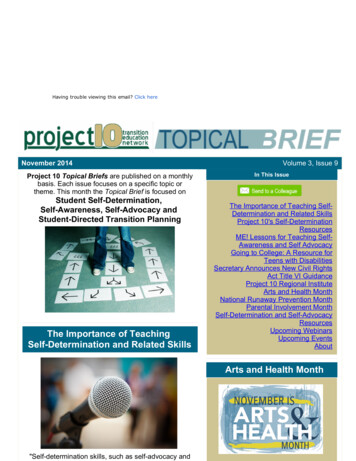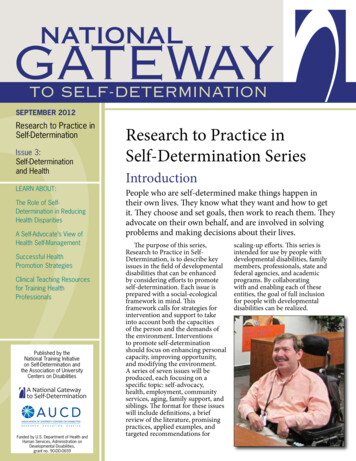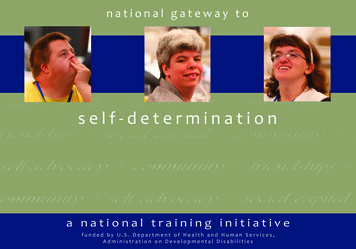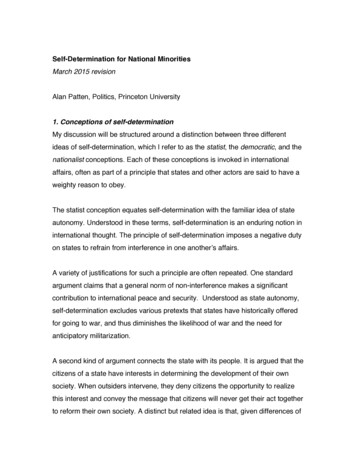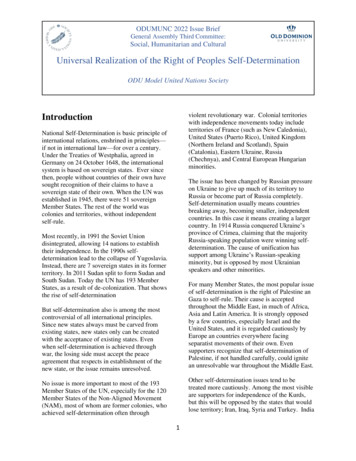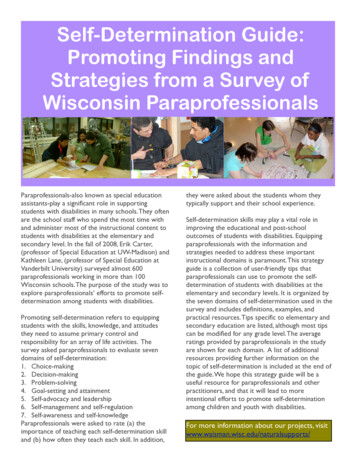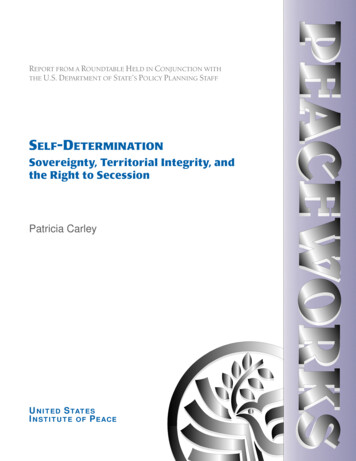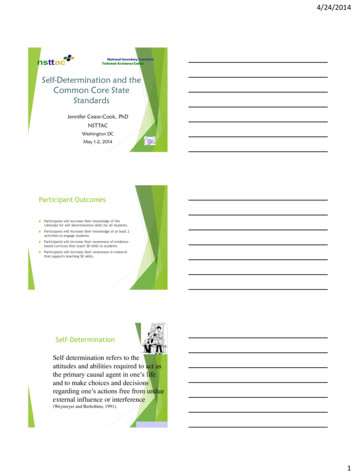
Transcription
4/24/2014National Secondary TransitionTechnical Assistance CenterSelf-Determination and theCommon Core StateStandardsJennifer Cease-Cook, PhDNSTTACWashington DCMay 1-2, 2014Participant Outcomes Participants will increase their knowledge of therationale for self determination skills for all students. Participants will increase their knowledge of at least 2activities to engage students Participants will increase their awareness of evidencebased curricula that teach SD skills to students Participants will increase their awareness in researchthat supports teaching SD skills.Self-DeterminationSelf determination refers to theattitudes and abilities required to act asthe primary causal agent in one’s lifeand to make choices and decisionsregarding one’s actions free from undueexternal influence or interference(Weymeyer and Berkobien, 1991).1
4/24/2014The ability to stand upfor oneself andadvocate on one’s ownbehalfCalkins, C., Jackson, L. & Beckman, C. (2011, March). Self-Determination and Self-Advocacy, NationalTraining Initiative on Self-Determination.Nothing about mewithout me!NFL Statistics Every Year 100,000 high school footballplayers graduate and of that group:9,000 will play college football2000 will receive Division 1 scholarships1000 will sign a NFL contract250 will make an NFL roster125 will play four or more seasonsAnd for those players who make it to theNFL – staggering injury rates are common.2
4/24/2014Choice MakingDecisionMakingGoal ding, N. & Wehmeyer, M. (2010) It’s My Future. Washington, DC: USED – OSERS.3
4/24/2014Barriers to Self Determination Teachersand parents “know best.”to participate in life decisions. Lack of self-esteem, self-confidence, and apoor self-concept. Unrealistic expectations met with negativity. Lack of communication skills. Lack of life experiences Fear of risk-taking No motivationStrategies for Self-Determination Helpstudents see the link between dailydecisions and postsecondary goals Help students break long termpostsecondary goals into short termobjectives Ensure students recognize and understandPINS and learning styles Train students to request needed supports Support students when mistakes are made Provide positive but honest feedbackAdapted from Davis and Wehmeyer (1991)4
4/24/2014Strategies for Self-Determination Ensureaccess to good role modelsPowerPoint presentations oraugmentative communication devices toincrease communication Use Ensure understanding of the importance ofthe process and obtain a commitment toparticipate Use various planning formats to assist indetermining post-school goalsStrategies for Self-Determination Teach students about his/her legal rights Provide role-playing opportunities Arrange for students to meet teammembers in advance Use video-taping and peer review Let students bring a friend to the meeting Always debrief Include self-determination goals andobjectives on the IEPLike Stars in the Sky – Ideas are resentationTeacher-SharedPortfoliosScriptsCreating anInvitationAsking balListing tors5
4/24/2014Sink or Swim?Two GeneralApproaches to Promoting SD1.Integrating SD concepts and skills intothe Common Core Standards2.Using the student-driven IEP and/ortransition planning process17Infusing Secondary Transition Skillsinto CCSS Table6
4/24/2014Address Real Life (SD) TopicsReal life skill:Self-DeterminationStandard: Speaking and Listening,grade 6Present claims and findings,sequencing ideas logically and usingpertinent descriptions, facts,and details to accentuate main ideasor themes;use appropriate eye contact,adequate volume, and clearpronunciation.Instruction:Teach students to participate in their educational planning meetingsincluding identifying content (e.g., goals) and appropriate presentationbehaviors (e.g., eye contact, sitting up straight)Making Curricular ContentMore Meaningful and RelevantStandard:Academic Context:Reading: Key Ideas and To Kill a MockingbirdDetailsAnalyze how and whyindividuals, events, andideas develop andinteract over the courseof a text.Real life Skill:Self-DeterminationInstruction:Do a character study of Boo Radley. Analyze his relationships with othercharacters (e.g., Scout and Jem). Identify how the relationship changesand why including what makes him hide. Apply Boo’s situation to your own.Explain how your disability/difference affects your life and potentialfriendships.Making Curricular ContentMore Meaningful and RelevantStandard:Academic Context:11-12.2 Determine two Of Mice and Menor more themes orcentral ideas ofa text and analyze theirdevelopment over thecourse of thetext, including howthey interact and buildon one anotherto produce a complexaccount; provide anobjectivesummary of the text.Real life Skill:Self-DeterminationInstruction:Why did George and Lennie move so much? What are your dreams for the future? What supportwill you need? Example—postsecondary education (Disability Services and Meal Plan)7
4/24/2014Making Curricular ContentMore Meaningful and RelevantStandard:11-12.3 Analyze theimpact of the author’schoicesregarding how todevelop and relateelements of a story ordrama (e.g., where astory is set, how theaction is ordered,how the characters areintroduced anddeveloped).Academic Context:Real life Skill:Self-DeterminationInstruction:Read short stories and biographies about famous people. Discuss their situations and how theydidn’t give up in the face of adversity. Rosa Parks, Beethoven, and JK RowlingMaking Curricular ContentMore Meaningful and RelevantStandard:9-10.1 Cite strong andthorough textualevidence tosupport analysis ofwhat the text saysexplicitly as well asinferences drawn fromthe text.Academic Context:English/Language ArtsReal life Skill:Self-DeterminationInstruction:Choose two postsecondary education institutions or training programs and summarizeinformation from their website for prospective students. Identify one that would be anappropriate choice for postsecondary education/training and one that is not. Provide evidencethat supports the choice.Making Curricular ContentMore Meaningful and RelevantStandard:6.4 Produce clear andcoherent writing inwhich thedevelopment,organization, and styleare appropriate totask, purpose, andaudience. (Gradespecific expectationsfor writing types aredefined in standards 1–3 above.)Academic Context:English/Language ArtsReal life Skill:Self-DeterminationInstruction:Assignment to address an issue of concern through essay competition, writing a productcomplaint, writing letter to the school or local paper, or a letter to be read at a school boardmeeting.8
4/24/2014Literature Circles 8th and 9th grade students with disabilities showedimprovement in their perceptions of their readingskills and were able to contribute to discussions intheir literature circles Self-determination components addressed:problem-solving and decision-making ELA skills addressed: reading comprehension, oralcommunicationBlum, Lipsett, & Yocom (2002)GO 4 IT NOW! High-school students with cognitive andphysical disabilities showed improvement intheir abilities write IEP goal paragraphs andother types of expository paragraphs Self-determination components addressed:goal-setting, self-awareness, and selfregulation ELA skills addressed: writing for a variety ofpurposes, paragraph writingKonrad, Trela, & Test (2004)GO 4 IT NOW! in Practice Uses a mnemonic device to help students write 6-sentence goalparagraphs Can be applied to other types of paragraph writing9
4/24/2014GO 4 IT NOW!A Strategy to Teach Students toWrite Paragraphs about Their IEP GoalsGoalsObjectives4 (4 objectives)IdentifyTimelineName your topic.Order your steps.Wrap it up and restatetopic.Self-Realization WritingPortfolios High-school juniors and seniors with learningdisabilities or hearing impairments showedimprovements in self-awareness Self-determination components addressed:self-awareness, self-regulation, self-advocacy ELA skills addressed: writing for a variety ofpurposes, essay writing, readingcomprehension, and research skillsEisenman & Tascione (2002)Self-Realization Writing Portfolios in Practice Each student maintains a writing portfolioWriting topics related to disability or specialeducation Argumentessay about whether students withdisabilities should have to pass the state exam Brochure persuading students with disabilities tobecome self-advocates Self-assessment describing new learning relatedto special education needs and how new skillswill be applied in the future Personal essay about experiences of living with adisability Proposal outlining steps for transitioning fromone grade to another10
4/24/2014The Self-Determined LearningModel of InstructionPhase 1: Set a GoalPhase 2: Take ActionPhase 3: Adjust Goal or PlanMithaug, D. E., Wehmeyer, M. L., Agran, M., Martin, J. E., & Palmer,S. (1998).Phase 1: Set a Goal Problem for Student to Solve: What is My Goal? Student Question 1: What do I want to learn?Student Question 2: What do I know about it now?Student Question 3: What must change for me to learnwhat I don’t know?Student Question 4: What can I do to make this happen?Educational Supports: Student self-assessment of interests,abilities, and instructional needs; awareness training;choice-making instruction; problem-solving instruction;decision-making instruction; goal-setting instructionPhase 2: Take Action Problem for Student to Solve: What is My Plan? StudentQuestion 5:don’t know? Student Question 6:taking action? Student Question 7:barriers? Student Question 8: What can I do to learn what IWhat could keep me fromWhat can I do to remove theseWhen will I take action?Educational Supports: Self-scheduling, self-instruction, antecedent cueregulation, choice-making instruction, goal-attainment strategies,problem-solving instruction, decision-making instruction, self-advocacyinstruction, assertiveness training, communication skills training, selfmonitoring11
4/24/2014Phase 3: Adjust Goal or Plan Problem for Student to Solve: What Have ILearned?StudentStudentStudentknow? Student Question 9: What actions have I taken?Question 10: What barriers have been removed?Question 11: What has changed about what I don’tQuestion 12: Do I know what I want to know?Educational Supports: Self-evaluation strategies, choice-makinginstruction, problem-solving instruction, decision-makinginstruction, goal-setting instruction, self-reinforcement strategies,self-monitoring strategies, self-recording strategiesGoal Setting/Self-Regulation: StudentSupport Skills Student and teacher select goal(s) Design and teach student self-regulation strategy Self-monitoring Antecedent cues Self-evaluation Self-reinforcementWhat We Do in WritingCorrect spellingWrite paragraphs (topic sentence, detail sentences, closing or connectingsentence)Use correct punctuation (periods at the end of sentences, question marks,commas in a list)Write storiesWrite lettersWrite answers to questions about stories we’ve readWrite answers to questions in science or other subjectsUse capital letters for people’s names, names of places, beginning of sentencesWrite complete sentences (subject and verbUse details (adjectives and more sentences) to explain thingsWrite neatly, so that others can readComplete our writing assignmentsWork quietly when writingSit in seat when writingRead our writing aloud to others12
nstruction – encourages task completion andorganization through use of verbal reminders for eachstep A mnemonic device for remembering capital lettersand punctuation. ―I will put a period at the end of my sentences and Iwill proofread my work.‖ ―When I write I use a dictionary.‖ ―Draw a space ( ) between the words.‖ ―Place my pinky between each word.‖ ―Say the word slowly. Write those sounds.‖Self-Determination Contracts forAcademic Skills Teach students to fill out a daily SD contract Plan Work Evaluate Adjust13
4/24/2014Sample Self-Directed ContractSelf-determination contract regulates the adjustment of student behaviors to meet their goalsBecause I want to learn to , I agree to(#) days each week at school. I also agree tofor homework 2 days each week.Ms. and Ms. agree to help me complete these steps by providing me withinstruction, assignments to complete, and feedback on my performance.I agree to when reminded by my teachers, orgiven an assignment in my work folder.If Ms. and Ms. follow this contract, they will know they are helping me writebetter. If they do not follow this contract, they will know that have not helped me learn towrite better.If I follow this contract each day I will probably improve my writing and will have theopportunity to earn points. If I do not follow the contract, I may not improve my writingand I may lose points.Skills Taught through Involvement inIEP Process Describing one’s disability, strengths, needs, present level of performance Communicating one’s interests and preferences Engaging in goal setting and goal attainment activities Participating in discussions regarding school & post-school plans and needs Choosing & negotiating one’s accommodation needs Accepting responsibility for where improvement is needed Evaluating one’s progressActivity 6.6 Adapt speech to a variety of contexts and tasks,demonstrating command of formal English whenindicated or appropriate 9-10.3 Apply knowledge of language to understandhow language functions in different contexts, tomake effective choices for meaning or style, and tocomprehend more fully when reading or listening. 8.3 Use knowledge of language and its conventionswhen writing, speaking, reading, or listening. 8.3a Use verbs in the active and passive voiceand in the conditional and subjunctive mood toachieve particular effects (e.g., emphasizing theactor or the action; expressing uncertainty ordescribing a state contrary to fact).14
4/24/2014Web-Based ToolsUsing a ―toondoo‖ to expressaccommodations needed for a studentUsing ―picfont‖ to help a studentcommunicate their goals15
4/24/2014Using a ―wordle‖ to express a student’spreferences, interests, and strengthsEvidenced-Based Practices by SkillTaughtUsing Self-Management Instruction toTeach: Academic Skills (strong) Social Skills (moderate) Job Specific Skills (moderate)Using Self-Monitoring Instruction toTeach: Functional Life Skills (potential)Evidenced-Based Practices by SkillTaughtStudent Knowledge of Transition Planning Using Who’s Future Is It Anyway?Student Participation in IEP Meeting Using Check and Connect Using Computer Assisted Instruction Using the Self-Advocacy Strategy Using the Self-Directed IEP Using Published CurriculaSelf Determination Using Who’s Future Is It Anyway?Goal Attainment Using Self Determined Learning Model of Instruction16
4/24/2014Resources forSD Assessments and MaterialsZarrow Center for Enrichment and mlNSTTAC’s websitewww.nsttac.org – evidence-based practices – practice descriptions, lessonplans, annotated bibliographies; transition assessment toolkit – selfdetermination assessmentsResources on Standards www.corestandards.org – resources and current information on theadoption and implementation of the Common Core State Standards www.commoncore.org – a curriculum mapping project forresources regarding instruction and curriculum design, associatedwith the Core Standards www.ideapartnership.org - Collection on Core Standards www.nsttac.org 101 Documents on Secondary Special Educationissues, including College and Career Readiness www.cast.org www.careertech.org www.p21.org www.ncwd-youth.org /index.html www.parcconline.org; http://www.k12.wa.us/smarter/Contact UsJennifer Cease-Cook, jjcease@uncc.eduDavid Test, 327(TTY)704-687-2916 (fax)5117
Calkins, C., Jackson, L. & Beckman, C. (2011, March). Self-Determination and Self-Advocacy, National Training Initiative on Self-Determination. Nothing about me without me! NFL Statistics Every Year 100,000 high school football players graduate and of that group: 9,000 will play college football 2000 will receive Division 1 scholarships


